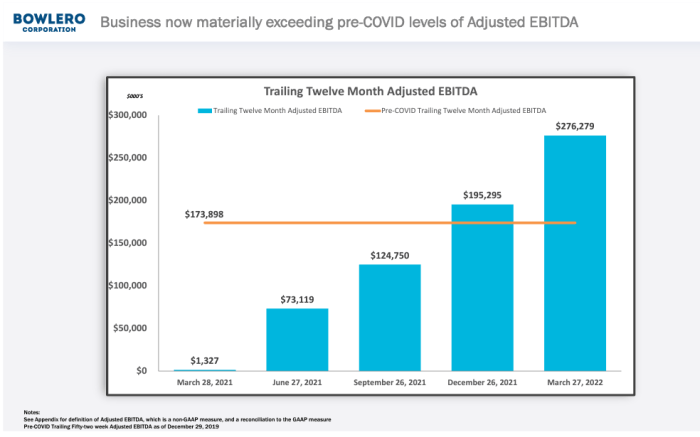Bowling Industry Overview
Bowling stock price – The bowling industry, while a seemingly niche market, encompasses a surprisingly diverse range of businesses, from large, publicly traded companies owning and operating numerous bowling centers to smaller, independent alleys. Its current state is a complex interplay of traditional entertainment, technological advancements, and economic factors. Market size fluctuates, influenced by trends in leisure spending and the appeal of competing entertainment options.
Major Players in the Bowling Industry
The bowling industry landscape is comprised of both large corporations managing multiple bowling centers and smaller, independent operators. While a definitive list of all players is difficult to compile due to the number of smaller, privately-held businesses, some publicly traded companies (where available) and prominent equipment manufacturers can be identified. The relative size and market share of these companies vary considerably.
Determining precise market share figures for all players is challenging due to the lack of publicly available, comprehensive data.
Historical Performance of the Bowling Industry
The bowling industry’s history mirrors broader societal trends. Periods of economic prosperity often correlate with increased participation and investment in bowling centers. Conversely, economic downturns can lead to reduced consumer spending on leisure activities, impacting the industry’s performance. Technological advancements, such as automated scoring systems and enhanced lane technologies, have also played a significant role in shaping the industry’s evolution.
Market Capitalization of Publicly Traded Bowling Companies
Precise market capitalization figures for publicly traded bowling companies require real-time data and can fluctuate significantly. The following table provides a hypothetical example illustrating how such data might be presented. Remember that actual figures vary considerably depending on market conditions.
| Company Name | Ticker Symbol | Market Cap (USD) | Country |
|---|---|---|---|
| Example Bowling Corp. | BOWL | $500 Million | USA |
| Global Bowling Inc. | GBOW | $200 Million | Canada |
| National Bowling Centers | NBC | $1 Billion | USA |
| International Bowling Group | IBG | $300 Million | UK |
Factors Affecting Bowling Stock Prices
Several interconnected factors influence the stock prices of publicly traded bowling companies. These range from broad macroeconomic conditions to specific industry trends and the performance of individual companies.
Macroeconomic Factors
Interest rates, inflation, and overall economic growth significantly impact consumer spending. Higher interest rates can reduce disposable income, affecting discretionary spending on entertainment like bowling. Inflation increases operating costs for bowling alleys, potentially squeezing profit margins.
Consumer Spending Habits
Consumer preferences and spending habits are crucial. Trends in leisure activities, the popularity of bowling compared to competing entertainment options, and the overall economic climate all influence demand for bowling services.
Technological Advancements
Technological advancements such as automated scoring systems, interactive games, and improved lane maintenance technologies can enhance the bowling experience, potentially attracting more customers and increasing revenue. Conversely, the initial investment in new technologies can impact profitability in the short term.
Seasonal Variations
Bowling alleys typically experience seasonal fluctuations in demand. Summer months might see lower attendance due to outdoor activities, while winter months may see increased patronage. These seasonal patterns can influence stock performance, with higher earnings during peak seasons and lower earnings during off-peak seasons.
Financial Performance of Bowling Companies
Analyzing the financial health of publicly traded bowling companies involves examining key metrics and ratios. This analysis provides insights into their profitability, growth potential, and financial stability.
Key Financial Ratios and Metrics
Profitability is assessed using metrics like net profit margin, return on assets (ROA), and return on equity (ROE). Revenue growth indicates the company’s ability to expand its business. Debt levels and capital structures show the company’s financial leverage and risk profile. Operating expenses reveal the cost structure of running a bowling alley.
Comparative Analysis of Profitability and Revenue Growth

Source: seekingalpha.com
A comparative analysis would involve comparing these key financial metrics across several publicly traded bowling companies to identify high-performing companies and those facing challenges. This comparison would highlight differences in business models, operational efficiency, and market positioning.
Debt Levels and Capital Structures
Examining debt-to-equity ratios and interest coverage ratios provides insights into the financial risk associated with investing in a particular bowling company. High debt levels can indicate financial strain, while lower debt levels suggest greater financial stability.
Operating Expenses of a Typical Bowling Alley
Operating expenses for a bowling alley typically include rent or mortgage payments, utilities, staff salaries, maintenance costs for lanes and equipment, marketing and advertising expenses, and insurance. The proportion of each expense category can vary depending on the size and location of the alley.
Competitive Landscape and Market Share: Bowling Stock Price
The bowling industry is characterized by a mix of large chains and smaller, independent alleys. Competition can be intense, particularly in densely populated areas. Understanding the competitive dynamics is crucial for assessing the prospects of individual companies.
Competitive Dynamics
Competition in the bowling industry involves vying for customers through pricing strategies, amenities offered, and the overall bowling experience. Large chains often compete on scale and brand recognition, while smaller alleys may focus on niche markets or personalized service.
Competitive Advantages
Key competitive advantages include prime location, modern facilities, attractive pricing, a strong brand reputation, and effective marketing strategies. Companies with superior operational efficiency and cost management can also gain a competitive edge.
Market Share
Precise market share data for individual bowling companies is often unavailable publicly. However, analyzing industry reports and financial statements of publicly traded companies can offer some insights into relative market positions.
Strategies for Gaining Market Share
- Expanding into new geographic markets
- Investing in facility upgrades and new technologies
- Implementing effective marketing and advertising campaigns
- Offering attractive pricing and promotions
- Developing strategic partnerships and alliances
- Improving customer service and creating a positive bowling experience
Future Outlook and Growth Projections
The future of the bowling industry depends on several factors, including evolving consumer preferences, technological innovations, and macroeconomic conditions. Predicting future growth requires considering these interwoven elements.
Future Trends and Opportunities
The industry may see continued growth in areas like corporate events, league bowling, and family entertainment centers that incorporate bowling alongside other attractions. Technological advancements could further enhance the bowling experience and attract new customers.
Growth Projections
Predicting precise growth figures is challenging due to the inherent uncertainties in the market. However, reasonable projections could be based on historical growth trends, considering factors like population growth, disposable income, and the industry’s ability to adapt to changing consumer preferences.
Impact of New Technologies
New technologies like virtual reality (VR) and augmented reality (AR) integration could revolutionize the bowling experience, making it more interactive and engaging. Data analytics can also help optimize operations and enhance customer service.
Influence on Stock Prices
Positive industry trends and successful technological implementations can boost investor confidence, potentially leading to higher stock prices. Conversely, negative trends or technological failures could negatively impact stock valuations.
Illustrative Examples of Bowling Stock Performance
Stock prices are highly sensitive to news and events. Positive news can lead to price increases, while negative news can trigger price declines. Understanding these dynamics is crucial for successful stock investment.
Positive News Event

Source: bigstockphoto.com
For example, the announcement of a successful new marketing campaign resulting in a significant increase in customer traffic and revenue could lead to a positive market reaction and a rise in the company’s stock price. Investors would see this as a sign of improved profitability and growth potential.
Negative News Event, Bowling stock price
Conversely, news of a major equipment malfunction affecting multiple bowling alleys, leading to significant operational disruptions and revenue loss, could cause a sharp decline in the company’s stock price. Investors would perceive this as a risk to future earnings.
Characteristics of a Typical Bowling Company Stock Chart
A typical bowling company stock chart would show price fluctuations influenced by seasonal trends, news events, and overall market conditions. Patterns such as upward or downward trends, consolidation periods, and breakouts could be observed. Technical analysis techniques can be used to interpret these patterns and potentially predict future price movements.
Fictional Press Release
Example: ” FOR IMMEDIATE RELEASE: [Company Name] Announces Record-Breaking Revenue and Expansion Plans. [City, State] – [Date] – [Company Name], a leading operator of bowling centers, today announced record-breaking revenue for the second quarter of [year], exceeding expectations by 15%. The company attributes this success to its innovative marketing campaigns and the continued popularity of bowling as a family-friendly entertainment option.
Furthermore, [Company Name] plans to expand its operations by opening three new bowling centers in key markets over the next year. This expansion is expected to further drive revenue growth and enhance the company’s market position.”
Questions Often Asked
What are the major risks associated with investing in bowling stocks?
Risks include economic downturns impacting consumer spending, increased competition from alternative entertainment options, and the potential for technological disruption within the industry.
How does seasonality affect bowling stock prices?
Bowling alleys typically see higher revenue during the colder months and lower revenue during the summer. This seasonality can influence stock prices, creating predictable patterns of fluctuation.
Analyzing bowling stock price requires a multifaceted approach, considering market trends and competitor performance. Understanding similar industry dynamics is crucial, and a good comparison point could be the current performance of bdcc stock price , which operates within a related sector. Ultimately, a comprehensive assessment of bowling’s stock price necessitates a broad market analysis, including the insights gleaned from these comparisons.
Are there any publicly traded bowling equipment manufacturers?
Research is needed to identify specific publicly traded companies specializing in bowling equipment manufacturing. The availability of such companies varies by region and market.
How can I find historical stock data for bowling companies?
Financial data providers such as Yahoo Finance, Google Finance, and Bloomberg offer historical stock data for publicly traded companies. You will need to identify the relevant stock tickers for the companies you wish to research.
